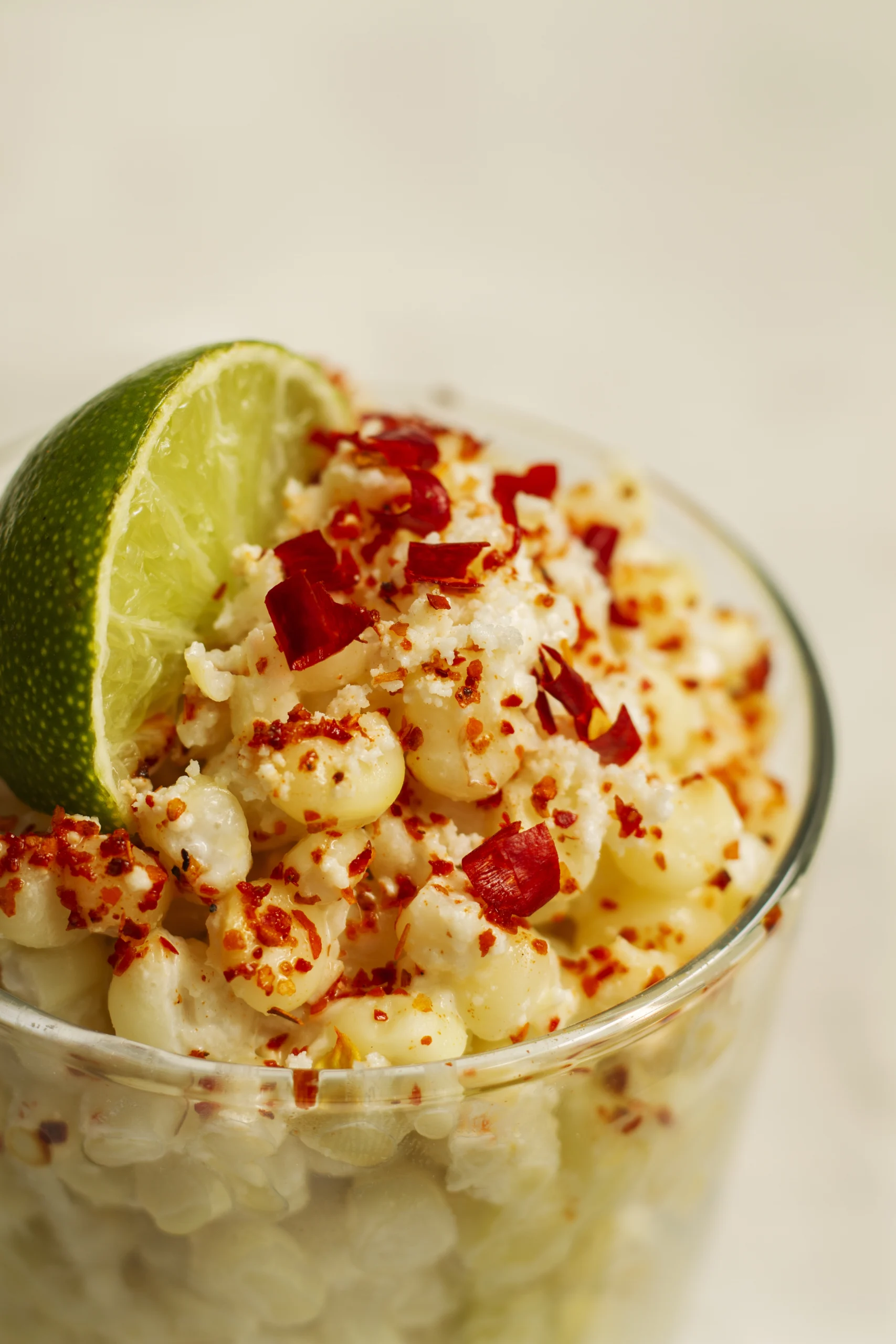Leche de Tigre, or “tiger’s milk” in English, is a bold and zesty Peruvian marinade traditionally used to cure raw fish in ceviche. More than just a byproduct of ceviche, Leche de Tigre has gained fame in its own right—as a flavorful shot, a hangover cure, and even a popular appetizer. Its base is a vibrant mix of freshly squeezed lime juice, fish juices (from marinating the seafood), garlic, onion, cilantro, chili peppers, and a touch of salt. The result is a punchy, citrusy liquid packed with umami and heat.
In Peru, Leche de Tigre is revered not only for its flavor but also for its energizing and restorative properties. Some locals consider it an aphrodisiac, while others swear by it as the ultimate cure for a hangover or a midday pick-me-up. It’s typically served cold in small glasses, sometimes garnished with corn, shrimp, or cancha (toasted corn).
Though deeply rooted in Peruvian coastal cuisine, its popularity has spread globally. Chefs and food lovers around the world now experiment with their own versions—some sweet, others spicy or tropical. Despite the variations, the essence of Leche de Tigre remains the same: bold, fresh, and unforgettable.
The Cultural Significance of Leche de Tigre
Leche de Tigre is more than just a flavorful concoction—it’s a cultural symbol in Peru. Deeply intertwined with Peruvian identity and cuisine, this citrusy, spicy liquid has roots that trace back centuries, emerging alongside the evolution of ceviche. While ceviche is celebrated as Peru’s national dish, Leche de Tigre has taken on a distinct life of its own, celebrated in street food stalls, upscale restaurants, and home kitchens alike.
In coastal cities like Lima, Piura, and Trujillo, it’s not uncommon to see people sipping Leche de Tigre from shot glasses in the morning or as a midday boost. It’s often regarded as a natural energizer and is even marketed as a hangover remedy or aphrodisiac. According to local lore, the name “Leche de Tigre” is symbolic—the drink is said to “wake the tiger within you,” providing strength, vitality, and even courage.
Its popularity also reflects Peru’s culinary innovation, where humble ingredients are transformed into vibrant, flavorful experiences. Chefs in Peru and abroad have embraced Leche de Tigre, showcasing it in gourmet menus and reinventing it with new ingredients like passion fruit, mango, or even sake.
The cultural love for Leche de Tigre extends to social gatherings, family celebrations, and national festivals, where it’s often served alongside ceviche. It represents more than taste—it carries tradition, pride, and a passion for bold flavor.

Key Ingredients and Their Roles
At the heart of any good Leche de Tigre recipe is a vibrant balance of acidity, spice, freshness, and umami. Each ingredient plays a specific role in creating the signature punchy, revitalizing flavor profile that makes this Peruvian staple so beloved. Here’s a closer look at the key components:
1. Fresh White Fish or Seafood:
The backbone of Leche de Tigre. Traditionally, firm white fish like corvina or sea bass is used. The fish not only lends its flavor to the liquid but also releases natural proteins that give the mixture a slightly creamy, emulsified texture. Shrimp or scallops are also common additions in modern variations.
2. Fresh Citrus Juice (Lime and/or Lemon):
The defining element. The high acidity of lime juice “cooks” the seafood in ceviche, but in Leche de Tigre, it brings sharpness and brightness. Some recipes also use a bit of orange or mandarin juice for added complexity and sweetness.
3. Aromatics (Onion, Garlic, and Ginger):
Red onion adds a sharp, slightly sweet bite and beautiful color. Garlic deepens the flavor with its earthiness, while fresh ginger adds a peppery, zesty edge that enhances the drink’s refreshing qualities.
4. Cilantro (Coriander):
Cilantro gives Leche de Tigre its signature herbal freshness and green hue. It’s essential for aroma and balance.
5. Chili Peppers (Usually Aji Limo or Rocoto):
Spice is key. Aji limo is the traditional choice, bringing fruity heat. Adjusting the chili controls the intensity.
6. Salt and Pepper:
Simple yet essential. They enhance the flavors and bring everything into balance.
7. Optional Additions:
Some recipes include celery, fish stock, or even evaporated milk for creaminess. For modern twists, fruits like mango or passion fruit can be used to add sweetness and a tropical flair.
Step-by-Step Guide to Making Traditional Leche de Tigre
Making traditional Leche de Tigre at home is surprisingly easy, as long as you have fresh ingredients and a good blender. Here’s a step-by-step breakdown to guide you through the process and help you achieve a bold, balanced flavor that honors its Peruvian roots.
Ingredients:
- 1/2 lb (225g) fresh white fish (like corvina, sea bass, or tilapia), diced
- 1/2 red onion, thinly sliced
- 3–4 limes, freshly squeezed (about 1/2 cup juice)
- 1 garlic clove
- 1 small piece of fresh ginger (about 1 inch), peeled
- 1–2 aji limo or other chili pepper (adjust to taste)
- 1/4 cup fresh cilantro leaves
- Salt and white pepper, to taste
- 1/4 cup cold fish stock or ice water (optional, to loosen texture)
- Garnishes: corn kernels, cancha (toasted corn), shrimp, sweet potato slices
Instructions:
Step 1: Prep the Fish
Cut the fish into small cubes and keep it chilled. You can use a few small pieces in the Leche de Tigre base, and reserve the rest for garnishing or ceviche.
Step 2: Blend the Base
In a blender, combine the lime juice, garlic, ginger, chili pepper, cilantro, a few fish cubes, and sliced onion. Blend until smooth. This creates the essence of your Leche de Tigre.
Step 3: Season
Add salt and white pepper to taste. If the mixture is too thick or intense, add a splash of cold fish stock or ice water to balance it out.
Step 4: Strain (Optional)
For a smooth, drinkable consistency, strain the mixture through a fine sieve. If you prefer it chunkier, skip this step.
Step 5: Chill and Serve
Serve immediately, ice-cold, in a small glass or bowl. Garnish with thinly sliced onion, corn kernels, cooked shrimp, or a few pieces of marinated fish. Optional sides include sweet potato slices or plantain chips.
Leche de Tigre is best enjoyed fresh, right after blending, to preserve its bold flavor and bright acidity. It can also be made a few hours ahead and stored in the fridge, but avoid letting it sit too long, as citrus can overpower the subtler notes.
Variations of Leche de Tigre
While the traditional Leche de Tigre is a citrusy, spicy, seafood-forward marinade and drink, modern chefs and home cooks have put their own spin on it. These variations reflect Peru’s diverse culinary influences and global fusion trends, offering exciting new flavors while preserving the dish’s essence.
1. Spicy Leche de Tigre
For those who love heat, this variation amps up the chili content. Instead of just aji limo, some recipes incorporate rocoto (a fiery Peruvian pepper) or even habanero. The spice can be balanced with more citrus or a splash of orange juice for a slightly sweet counterpoint. Thinly sliced fresh chili can also be added as a garnish for extra punch.
2. Tropical Leche de Tigre
This variation introduces a fruity twist by adding tropical fruits like mango, passion fruit, or pineapple. These ingredients bring a sweet, tangy flavor that complements the citrus and chili. Passion fruit pulp, in particular, adds depth and texture. This version is popular in coastal and fusion-style restaurants.
3. Creamy Leche de Tigre
Evaporated milk or coconut milk can be added for a creamier consistency. This creates a velvety texture and tones down the acidity, making it more approachable for those who prefer a milder flavor. Some versions even blend in avocado for added richness.
4. Vegan Leche de Tigre
A plant-based version replaces fish with ingredients like hearts of palm, mushrooms, or tofu. Seaweed or kombu can be added for umami depth, while vegetable stock and lime juice create the base. It’s a creative way to enjoy the essence of Leche de Tigre without seafood.
Common Mistakes to Avoid
Even though Leche de Tigre is relatively simple to make, a few common mistakes can impact the flavor, texture, and overall experience. Here’s what to watch out for:
1. Using Low-Quality or Not-So-Fresh Fish
Leche de Tigre is all about fresh, clean flavors, and the fish plays a central role. Using frozen, old, or poor-quality seafood can result in off flavors and unpleasant textures. Always go for the freshest fish possible—preferably sushi-grade.
2. Over-Blending or Over-Marinating
While blending the ingredients is essential to create a smooth base, over-processing the fish can make the mixture cloudy or too thick. Similarly, marinating for too long can break down the fish’s texture and turn it mushy. If you’re including marinated seafood, keep the soaking time short—15 minutes max.
3. Unbalanced Flavor Profile
It’s easy to go overboard with lime or salt. Too much acidity can overpower the other flavors, while under-seasoning will leave the dish flat. Taste as you go and aim for harmony between citrus, salt, chili, and herbs.
4. Serving It Warm or Letting It Sit Too Long
Leche de Tigre should be served cold, ideally right after blending. Leaving it out or storing it for too long can dull the vibrant flavors and cause separation.
Traditional Serving Styles
In Peru, Leche de Tigre is not just a flavorful marinade—it’s also served and enjoyed on its own as a dish or drink. The presentation varies depending on the region, occasion, and even personal preference, but certain traditional elements remain consistent.
Typically, Leche de Tigre is served chilled in a small glass or ceramic bowl, often as a starter or as a bold, refreshing shot. It’s not uncommon to see it offered alongside ceviche or as a standalone appetizer in both street food settings and high-end restaurants. Because of its reputation as an energizer and hangover cure, it’s sometimes enjoyed mid-morning or early afternoon.
Common garnishes include thinly sliced red onions, fresh cilantro, a slice of chili pepper, and occasionally a few small cubes of fish or shrimp that have been briefly marinated in the mixture. Some versions also include cancha (toasted corn), boiled corn kernels, or chilled sweet potato slices on the side, providing contrasting textures and balancing the acidity.
In coastal regions, it’s also popular to serve Leche de Tigre in shot glasses, often with a spoonful of seafood or corn at the bottom—making it both a drink and a bite.
Beverage Pairings
Pairing the right beverage with Leche de Tigre can elevate the overall experience, especially when served as a starter or during a social gathering. Because of its bright acidity, bold citrus notes, and touch of heat, it pairs best with drinks that can either balance or complement those intense flavors.
1. Pisco Sour
As Peru’s national cocktail, the Pisco Sour is a natural companion. Its smooth, slightly sweet profile with a citrusy punch harmonizes well with Leche de Tigre’s tanginess. The frothy egg white layer also adds a rich contrast to the sharp marinade.
2. Chicha Morada
For a non-alcoholic option, Chicha Morada—a traditional purple corn drink flavored with pineapple, cinnamon, and cloves—offers a sweet and aromatic counterbalance. Its deep, fruity flavor tempers the spice and acidity of Leche de Tigre beautifully.
3. Light Beers or Sparkling Water
Crisp, cold lagers or pilsners make refreshing pairings, cutting through the richness and resetting the palate. Sparkling water with lime is another excellent choice, especially if you want to highlight the Leche de Tigre without overpowering it.

Nutritional Breakdown
Leche de Tigre, while rich in flavor, is also a surprisingly nutritious drink. Its key ingredients—fish, citrus, and herbs—combine to provide a variety of vitamins, minerals, and healthy fats. Here’s a general breakdown of its nutritional profile:
1. Protein and Omega-3 Fatty Acids (from Fish):
The fresh fish used in Leche de Tigre is a good source of lean protein and omega-3 fatty acids, which promote heart health and support brain function. A 3-ounce serving of fish can provide about 15-20 grams of protein.
2. Vitamin C (from Citrus):
The lime juice in Leche de Tigre is packed with vitamin C, an essential nutrient that supports immune function, skin health, and acts as an antioxidant. One lime typically contains about 20-30% of the daily recommended intake of vitamin C.
3. Healthy Fats (from Fish and Optional Additions):
If you choose to add ingredients like avocado or coconut milk (in some variations), you get healthy monounsaturated and polyunsaturated fats, which are beneficial for heart health.
4. Fiber and Antioxidants (from Herbs and Spices):
Cilantro, garlic, and ginger not only provide aromatic flavor but also contribute fiber, antioxidants, and anti-inflammatory properties, making this dish a nutrient-dense option.
Health Benefits
Leche de Tigre isn’t just delicious—it also offers several health benefits thanks to its fresh, nutrient-packed ingredients. Here are some of the key health advantages:
1. Supports Digestion:
The combination of fresh lime juice, garlic, and ginger is known for its digestive benefits. Lime juice stimulates the production of digestive enzymes, while ginger aids in reducing bloating and nausea. Garlic also has antimicrobial properties, which help in gut health.
2. Rich in Antioxidants:
The cilantro and other herbs used in Leche de Tigre are packed with antioxidants, which help fight oxidative stress in the body. Antioxidants are crucial for protecting cells from damage, reducing inflammation, and preventing chronic diseases.
3. Heart Health Benefits:
The fish used in Leche de Tigre is an excellent source of omega-3 fatty acids, which are linked to improved heart health. Omega-3s help lower bad cholesterol (LDL) and reduce the risk of cardiovascular disease. The inclusion of fresh vegetables and herbs also supports overall heart health.
4. Immune Boosting:
The high vitamin C content from the citrus, particularly lime, strengthens the immune system, helping the body fight off infections and illnesses. Vitamin C is also essential for the production of collagen, which is vital for skin and tissue repair.
Common Queries
When it comes to Leche de Tigre, many people have questions about its preparation, variations, and uses. Here are some common queries answered:
1. Can Leche de Tigre be made without fish?
Yes, you can create a vegan version of Leche de Tigre using plant-based ingredients like hearts of palm, tofu, or mushrooms as substitutes for fish. The marinade remains similar, relying on citrus, herbs, and spices to achieve the signature tangy, spicy flavor.
2. How long can Leche de Tigre be stored?
Leche de Tigre is best enjoyed fresh, ideally within a few hours of preparation. However, it can be stored in an airtight container in the fridge for up to 24 hours. Be sure to give it a stir before serving, as the ingredients may separate over time.
3. Is Leche de Tigre spicy?
Leche de Tigre can be spicy, depending on the amount and type of chili used. The traditional aji limo pepper adds a medium heat, but you can adjust the spice level by adding more or less chili according to your preference.
4. Can I use frozen fish for Leche de Tigre?
While fresh fish is recommended for the best taste and texture, frozen fish can be used if it’s thawed properly and of high quality. Just ensure it’s fresh upon thawing to avoid compromising the flavor.
Conclusion
Leche de Tigre is more than just a flavorful Peruvian drink—it’s a cultural treasure that embodies the vibrant, fresh, and bold flavors of Peru’s coastal cuisine. Whether you’re sipping it as a tangy shot, enjoying it with ceviche, or experimenting with variations, this iconic drink offers something for everyone, from its rich history to its delicious, nutrient-packed ingredients.
The key to making the perfect Leche de Tigre lies in using fresh, quality ingredients and balancing the essential flavors of citrus, spice, and herbs. Whether you stick to the traditional recipe or explore modern twists, this dish showcases the versatility and ingenuity of Peruvian cooking.
Beyond its incredible taste, Leche de Tigre boasts numerous health benefits, from supporting digestion to providing essential vitamins and antioxidants. It’s not only a refreshing way to enjoy seafood but also a powerful elixir that brings a little taste of Peru into your home.
So, next time you’re craving a unique, bold beverage or a fantastic starter, consider whipping up a batch of Leche de Tigre. With its dynamic flavors and cultural significance, it’s sure to impress your guests or add excitement to your next meal.

